Neanderthal News 2020 - II. the Denisovans
See:
Neanderthal News 2020: Part I: the Superarchaics
Scientists reconstruct skeletal anatomy of Denisovans
A team of researchers from Israel and Spain has produced reconstructions of Denisovans, an extinct sister group of Neanderthals, based on patterns of methylation — chemical changes — in their ancient DNA.
“We provide the first reconstruction of the skeletal anatomy of Denisovans. In many ways, they resembled Neanderthals, but in some traits, they resembled us, and in others they were unique,” said senior author Dr. Liran Carmel, a researcher with the Hebrew University of Jerusalem.
The Denisovan girl
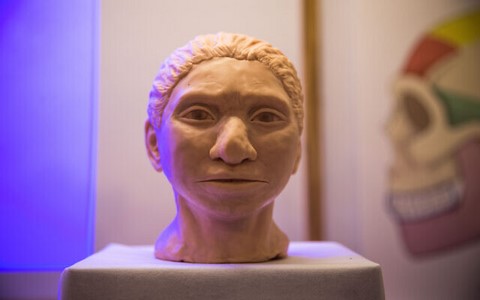
The reconstruction of what an ancient Denisovan female head may have looked like according to researchers from the Hebrew University, presented during a press conference at the Hebrew university on September 19, 2019.
The prestigious scientific journal Science announced that Israeli scientists’ reconstruction of the face of an ancient girl, an elusive cousin to modern humans and Neanderthals, has won the “People’s Choice” category of its Breakthrough of the Year contest. Hebrew University researchers Prof. Liran Carmel and Dr. David Gokhman used DNA from excavated remains to give a face to humanity’s “newest” ancient relative, the Denisovans, and produced from the likeness of a teenage girl who likely lived around 70,000 years ago. In a final round of voting, the Israeli research won 49 percent of the 34,000 online votes beating the three other candidates. It was named among four finalists including the discovery of new Ebola drugs, a technique that made a black hole “visible,” and a new cystic fibrosis drug
First discovered in a Siberian cave in 2008, the Denisovans coexisted with Neanderthals and modern Homo sapiens some 100,000 years ago. However, unlike their Neanderthal relatives, the paucity of verified Denisovan remains — and their highly fragmented state — has until now made it impossible to create an anatomical picture of this early man.
The groundbreaking Israeli technique helped to finally lift the veil. Carmel’s and Gokhman’s model “gave the world a glimpse of this nearly unknown ancestor of modern-day humans,” the university said.
They discovered a method of reconstructing what our long-ago relatives may have looked like by using open-source sequencing of ancient Denisovan DNA taken from a single bone fragment. Professors Eran Meshorer from the Hebrew University, Yoel Rak from Tel Aviv University, and Tomas Marques-Bonet from Barcelona’s Institute of Evolutionary Biology (UPF-CSIC) also contributed to the study.
After some 40 years of excavation in Siberia’s Anui River Valley, scientists in 2008 discovered the remains of a previously unknown form of ancient human. At the time, only a microscopic bone fragment, which underwent DNA analysis in Germany together with the rest of the findings from the cave, turned out to be from a human who was neither Neanderthal nor Homo sapiens.
After that first tiny fragment, which was part of a pinkie finger, scant other clearly determined Denisovan bone fragments were discovered, including a few teeth and recently a jawbone in Tibet. But the DNA of the Denisovans is still around in modern humans, including some six percent of aboriginal Australians, Malaysians and some other Southeast Asian populations. It may be part of the remarkable genetic differences seen in Inuits and Tibetans that allows their bodies to better handle extreme cold and high altitudes, the Israeli researchers have said.
Dr. Carmel and his colleagues came to their conclusions after three years of intense work studying DNA methylation maps.
DNA methylation refers to chemical modifications that affect a gene’s activity but not its underlying DNA sequence.
The scientists first compared DNA methylation patterns among the three human groups to find regions in the genome that were differentially methylated.
Next, they looked for evidence about what those differences might mean for anatomical features — based on what’s known about human disorders in which those same genes lose their function.
“By doing so, we can get a prediction as to what skeletal parts are affected by differential regulation of each gene and in what direction that skeletal part would change — for example, a longer or shorter femur,” said lead author Dr. David Gokhman, also from the Hebrew University of Jerusalem.
To test this ground-breaking method, the team applied it to two species whose anatomy is known: the Neanderthal and the chimpanzee.
They found that roughly 85% of their trait reconstructions were accurate in predicting which traits diverged and in which direction they diverged. Then, they applied this method to the Denisovan and were able to produce the first reconstructed anatomical profile of the mysterious Denisovan.
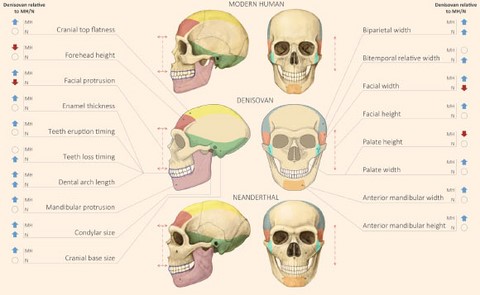
Comparison of modern human, Neanderthal and Denisovan skulls. Image credit: Maayan Harel.
The authors identified 56 anatomical features in which Denisovans differed from modern humans and/or Neanderthals, 34 of them in the skull.
For example, the Denisovan skull was probably wider than that of modern humans or Neanderthals. They likely shared Neanderthal traits such as an elongated face and a wide pelvis. They also had an increased dental arch and lateral cranial expansion.
"One of the most exciting moments happened a few weeks after we sent our paper to peer-review,” Dr. Carmel said. Scientists had discovered a Denisovan jawbone! We quickly compared this bone to our predictions and found that it matched perfectly.” “Without even planning on it, we received independent confirmation of our ability to reconstruct whole anatomical profiles using DNA that we extracted from a single fingertip.”
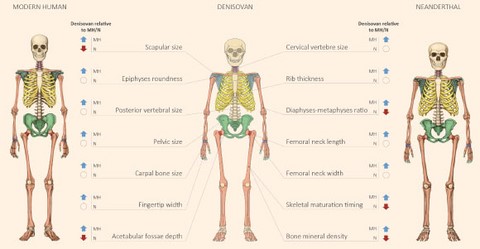
Anatomical comparison of modern human, Neanderthal and Denisovan skeletons. Image credit: Maayan Harel.
The findings show that DNA methylation can be used to reconstruct anatomical features, including some that do not survive in the fossil record. The approach may ultimately have a wide range of potential applications.
“Studying Denisovan anatomy can teach us about human adaptation, evolutionary constraints, development, gene-environment interactions, and disease dynamics,” Dr. Carmel said. “At a more general level, this work is a step towards being able to infer an individual’s anatomy based on their DNA.”
The team’s paper was published in the journal Cell. David Gokhman et al. 2019. Reconstructing Denisovan Anatomy Using DNA Methylation Maps. Cell 179 (1): 180-192; doi: 10.1016/j.cell.2019.08.035
This article is reproduced from Science-News
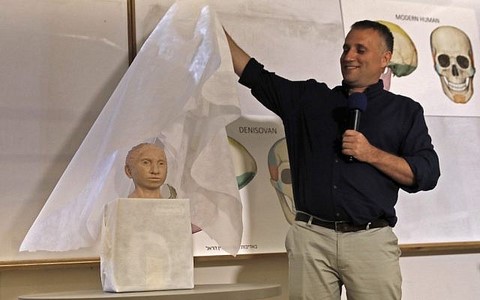
Liran Carmel of Hebrew University reveals a 3D printed model of the face of prehistoric human species Denisovan
during a press conference at the Hebrew University in Jerusalem on September 19, 2019. (MENAHEM KAHANA / AFP)
Denisovan mitochondrial DNA found in Tibetan cave
In 1980, the 160,000-year-old fossilized partial jawbone of a Denisovan — the so-called Xiahe mandible — was found in Baishiya Karst Cave, a limestone cave at the northeast margin of the Tibetan Plateau. Now, an international team of researchers has extracted genetic material from the sediments in Baishiya Karst Cave and identified mitochondrial DNA (mtDNA) from Denisovans indicating their presence at about 100,000 years ago, 60,000 years ago, and possibly 45,000 years ago. This discovery is the first time Denisovan DNA has been recovered from a location that is outside Denisova Cave in Siberia.
Denisovans are an extinct hominin group initially identified from a genome sequence determined from a fragment of a finger bone found at Denisova Cave in the Altai Mountains in southern Siberia.
Subsequent analyses of the genome have shown that Denisovans diverged from Neanderthals 400,000 years ago and that at least two distinct Denisovan populations mixed with ancestors of present-day Asians.
The only physical remains of Denisovans discovered so far in Siberia are a fragmentary finger bone, three teeth, and a skull fragment, all of which were found at Denisova Cave.
In 2019, the Xiahe mandible from Baishiya Karst Cave — dated to at least 160,000 years ago — was identified to be of Denisovan origin.
However, this identification of the fossil as Denisovan is based on a single amino acid position and is therefore tenuous.
In the new study, a team of scientists from China, Australia, Germany, and the United States found evidence for the long-term presence of Denisovans in Baishiya Karst Cave and described stratigraphic and chronological context for their occupation in the cave.
“When we started developing this project about ten years ago, none of us expected Baishiya Karst Cave to be such a rich site,” said co-author Dr. Charles Perreault, a researcher in the Institute of Human Origins and the School of Human Evolution and Social Change at Arizona State University. “We’ve barely scratched the surface — three small excavation units have yielded hundreds of stone tools, fauna and ancient DNA. There’s a lot that remains to be done.”
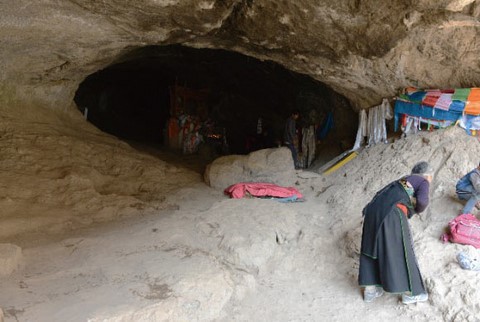
Dr. Perreault and colleagues extracted genetic material from Baishiya Karst Cave sediments and identified Denisovan mtDNA within them.
The findings indicate that Denisovans occupied the high-altitude cave as early as 100,000 years ago, and possibly as recently as 45,000 years ago, as well as at a point in-between.
“Finding Denisovan DNA on the Tibetan Plateau itself is surprising. Evidence of archaic hominins 2,000 m above sea level is unusual,” they said. “Life this high on the plateau is harsh for many reasons, including its thin air, and humans can develop altitude sickness anywhere above 2,500 m above sea level.” “This suggests that the Denisovans may have evolved adaptations to high altitude, much like modern Tibetans.”
“The dates of the sediments with mtDNA, along with the older Xiahe mandible, suggest that the Denisovans have been on the Plateau perhaps continuously for tens of thousands of years — more than enough for genetic adaptations to emerge.”
The Denisovan fossil and their mtDNA from Baishiya Karst Cave indicate that early modern humans coexisted in Asia with other archaic hominins, but, unexpectedly, that they interbred with them.
Like Neanderthals, Denisovan populations intermixed with modern humans as they dispersed into Asia.
“Baishiya Karst Cave is an extraordinary site that holds tremendous potential to understand human origins in Asia,” Dr. Perreault said. “Future work in Baishiya Karst Cave may give us a truly unique access to Denisovan behavior and solidifies the picture that is emerging, which is that Denisovans, like Neanderthals, were not mere offshoots of the human family tree — they were part of a web of now-extinct populations that contributed to the current human gene pool and shaped the evolution of our species in ways that we are only beginning to understand.”
The findings were published in the journal Science. Dongju Zhang et al. 2020. Denisovan DNA in Late Pleistocene sediments from Baishiya Karst on the Tibetan Plateau. Science 370 (6516): 584-587; doi: 10.1126/science.abb6320
Original article in sci-news.com
Scientists sequence Y chromosome DNA of Denisovans and Neanderthals
The genomes of our closest relatives, Neanderthals and Denisovans, have been sequenced and compared with that of modern humans. However, most archaic individuals with high-quality sequences available have been female. In new research, a team of geneticists from the United States, China and Europe has sequenced the paternally inherited Y chromosomes from three Neanderthals and two Denisovans; comparisons with archaic and modern human Y chromosomes indicated that, similar to the maternally inherited mitochondrial DNA (mtDNA), the human and Neanderthal Y chromosomes were more closely related to each other compared with the Denisovan Y chromosome; this result supports the conclusion that interbreeding between early Homo sapiens and Neanderthals replaced the more ancient Denisovian-like Y chromosome and mitochondria in Neanderthals.
A growing number of ancient DNA studies on Neanderthals, Denisovans and Homo sapiens suggest intertwined evolutionary and population histories, including several admixture events between early modern and archaic humans.
However, ancient nuclear and mtDNA sequences revealed phylogenetic discrepancies between the three groups that are hard to explain.
For example, autosomal genomes show that Neanderthals and Denisovans are sister groups that split from modern humans more than 550,000 years ago.
However, all but the earliest Neanderthal mtDNA samples are far more similar to those of modern humans than to those from Denisovans.
These studies suggest that Neanderthals originally carried a Denisovan-like mtDNA, which was later replaced through early admixture with early modern humans, likely between 350,000 and 150,000 years ago.
While genomic data for the paternally inherited Y chromosome would help resolve puzzling gene flows, virtually none of the male Neanderthal and Denisovan remains studied to date contain well-preserved Y chromosome DNA.
To address this gap, Dr. Martin Petr from the Max Planck Institute for Evolutionary Anthropology and his colleagues used a targeted capture-based DNA sequencing approach to enrich and extract Y chromosome sequences from the remains of three male Neanderthals and two male Denisovans.
The researchers found that, like maternally inherited mtDNA, modern human and Neanderthal Y chromosomes were more related to each other than to the Denisovan Y, supporting the suggestion that interbreeding between early humans and Neanderthals and subsequent selection led to the total replacement of more ancient Denisovan-like genetic material in late Neanderthals.
“This was quite a surprise to us,” said Dr. Petr, first author of the study. “We know from studying their autosomal DNA that Neanderthals and Denisovans were closely related and that humans living today are their more distant evolutionary cousins.” “Before we first looked at the data, we expected that their Y chromosomes would show a similar picture.”
The authors also found that the Y chromosomes of Denisovans split around 700,000 years ago from a lineage shared by Neanderthals and modern human Y chromosomes, which diverged from each other around 370,000 years ago.
“We speculate that given the important role of the Y chromosome in reproduction and fertility, the lower evolutionary fitness of Neanderthal Y chromosomes might have caused natural selection to favor the Y chromosomes from early modern humans, eventually leading to their replacement,” Dr. Petr said.
“If we can retrieve Y chromosome sequences from Neanderthals that lived prior to this hypothesized early introgression event, such as 430,000-year-old Neanderthals from Sima de los Huesos in Spain, we predict that they would still have the original Neanderthal Y chromosome and will therefore be more similar to Denisovans than to modern humans,” said study senior author Dr. Janet Kelso, also from the Max Planck Institute for Evolutionary Anthropology.
The findings are published in the journal Science. Martin Petr et al. 2020. The evolutionary history of Neanderthal and Denisovan Y chromosomes. Science 369 (6511): 1653-1656; doi: 10.1126/science.abb6460
Original article in sci-news.com
Denisovan fingers are indistinguishable from those of modern humans, researchers say
Denisovans lived in Asia for hundreds of thousands of years, sometimes interbreeding with Neanderthals and perhaps archaic humans, with some present-day human populations still carrying Denisovan DNA.
However, only five skeletal remains are known from Denisovans, mostly molars.
In 2010, a small fragment of a finger bone yielded the Denisovan mitochondrial genome that changed our view of the evolution of hominin lineages in Eurasia.
But the specimen, dubbed Denisova 3, was too incomplete to reveal useful morphological information about the whole appendage.
In the new study, Dr. Andrew Bennett of the University Paris Diderot and colleagues identified the larger distal part of the original Denisova 3 finger bone.
The researchers matched the missing fragment to the original by using DNA extraction and sequencing techniques to capture its entire mitochondrial DNA sequence.
Dr. Bennett and co-authors also reanalyzed scans and photographs of the Denisovan finger fragments and compared them with finger bones from Neanderthals, as well as Pleistocene and recent modern humans at various stages of development.“The digit was a fifth finger bone from the right hand of an adolescent female Denisovan who likely died at about 13.5 years old,” they said.
The findings appear in the journal Science Advances. E. Andrew Bennett et al. 2019. Morphology of the Denisovan phalanx closer to modern humans than to Neanderthals. Science Advances 5 (9): eaaw3950; doi: 10.1126/sciadv.aaw3950“We show that their dimensions and shape are within the variability of Homo sapiens and distinct from the Neanderthal fifth finger phalanges,” the scientists said. “Researchers should take caution when identifying potential Denisovan skeletal remains, since they may appear more similar to modern humans than to Neanderthals,” they added.

